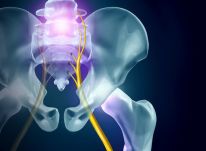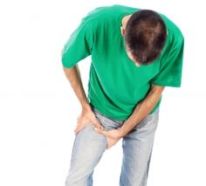The 4 Causes of All Sciatica - Which Is Causing Your Pain?
By Jesse Cannone, CFT, CPRS, MFT

If you’re reading this article on Sciatica and sciatic pain, it’s a good bet you have a radiating pain running down the back of your leg that just won’t go away.
If what I’m about to tell you sounds familiar, don’t worry, help is on the way.
I guarantee you that what you are about to read – and listen to – will be far different than what you have read or heard anywhere else!
First, let me tell you why today’s traditional treatment methods for sciatic nerve pain flat out miss the boat.
The medical community remains so conditioned and focused on treating only the symptoms and trying to get in as many patients a day as possible that many are misdiagnosed and/or mistreated.
In order to get rid of your sciatica you must first know what caused your pain. While sciatic pain is simply caused by pressure being placed on the sciatic nerve, one or more of these four causes are almost always the culprit:
Condition 1. – Piriformis Syndrome
This most common cause of sciatic pain occurs when pressure is placed on the sciatic nerve by the piriformis muscle. Muscle imbalances in your lower back, core, hips and thighs pull your hip joints and pelvis out of place. This changes the position of the piriformis muscle, which can touch and irritate the sciatic nerve. Whatever the case, muscle imbalances like these, left uncorrected, almost always cause major problems. That’s why muscle imbalances are the primary underlying cause of sciatica due to piriformis syndrome.
Condition 2. – Herniated Discs
Pressure caused by a herniated or bulging disc may also cause sciatica. When a disc protrudes out from between the vertebrae – whether caused by an event like a car accident or by months of uneven pressure due to muscle imbalances – the slightest pressure on a nerve can create pain. While herniated discs can cause sciatic pain, it’s important to note many people with herniated discs never experience pain or other symptoms. So even if you discover you have a herniated disc, it may or may not be the cause of your sciatica.
Condition 3. – Spinal Stenosis
Pressure caused by spinal stenosis, which is a decrease in the space between the vertebrae, can pinch nerves along the spinal column. This is primarily caused by uneven pressure and compression due to muscle imbalances.
Condition 4. – Isthmic Spondylolisthesis
Pressure caused by isthmic spondylolisthesis, which is simply when a vertebrae slips or moves out of its normal spinal alignment, can sometimes pinch the sciatic nerve. Imbalances in muscle strength often contribute to this condition. Again, like herniated discs, many with this condition have no sciatic pain, symptoms, or even know they have it!
As you can see, there is a trend here…
In nearly every case of sciatica, muscle imbalances are the primary cause of the pressure being placed on the sciatic nerve…
If you are not sure which one of the four is causing your sciatica, I recommend you start with the basics. Most cases of sciatic pain are caused by muscle imbalances, so if you begin correcting any muscle imbalances you have, you should notice improvement right away… and likely eliminate your sciatic pain in a few weeks or less!
While muscle imbalances are the most likely cause of sciatica without a known cause, it can also occur from trauma. Or, even more likely, a combination of both…
A traumatic event scenario is the most likely catalyst for sudden onset of sciatic pain. So here’s what happens… when there is undue stress on the piriformis muscle, that stress causes it to go into spasm and then you have pain due to the piriformis muscle putting pressure on the sciatic nerve which runs past the same area and, in some individuals, directly through the muscle.

In most cases, people go to physical therapy or minimize their physical activity to break the pain-spasm cycle. In most cases symptoms subside. However, the event could also set you up for a lifetime of sciatic pain if the piriformis muscle does not fully recover in both strength and flexibility.
Following a muscle injury, both strength and flexibility are compromised. If your recovery ends before strength and flexibility return to normal, you will never be 100% and may struggle with the problem for the rest of your life.
Another way sciatic pain creeps into your life is due to your lifestyle and habits. This is what we like to call the process. The process can be described as a prolonged onset of symptoms based on your everyday activities…
However, from a technical standpoint the process really describes the development of the muscle imbalance in your hip. The piriformis muscle is responsible for external rotation (moving your leg so your feet point outward). Over time, that muscle tends to get tight from the positions you put yourself in and weakens from lack of use.
Let me give you some examples of what I mean:
- If you frequently sit on your chair with your legs separated and feet pointed outward, this posture keeps your piriformis muscle in a shortened and tightened state. Extended periods of sitting in that position without counteracting the position with stretching causes the piriformis muscle to become chronically tight and lose flexibility. Hence the imbalance. 2, Another example would be competing or highly active runners and bikers. While they work hard, they tend to get sciatica because they fail to keep a strength vs. stretch balance in their workouts. Hence the imbalance creates a greater pull toward external rotation and again the result is a tight piriformis muscle and an irritated sciatic nerve.
These are just two examples of how muscle imbalances can affect the piriformis muscle and cause sciatic pain. You may not be a runner or cyclist, but I’ll bet you have muscle imbalances that are contributing to or directly causing your sciatic pain!
So how do you get rid of your sciatic pain?
Could learning one new stretch be enough? It very well may be. However, depending on the severity of your condition, you may need to incorporate new activities that include the use of the hip rotators such as rollerblading, basketball and tennis.
As always, learn as much as you can about your condition, so that you can ask the tough questions to your healthcare providers and get the best care possible.
FREE Report
101 Ways Enzymes Can Help You End Joint Pain, Stop Disease and Live Longer!

Most Popular Posts

How Long Does Sciatica Last?
If you’re dealing with a painful sciatica flare-up, you likely...
[Read More…]
Your Sciatica Relief Action Plan
To get sciatica relief you need to understand more about...
[Read More…]